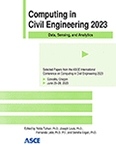BIM, IoT, and Data Mining Integration Framework for Improving Green Building Energy Resilience
Publication: Computing in Civil Engineering 2023
ABSTRACT
Green buildings (GB) aim to minimize the environmental impact of construction and operation activities. The adoption of building information modeling (BIM), the Internet of Things (IoT), and data mining (DM) presents promising opportunities for managing GBs with high energy efficiency. However, research on integrating these digital technologies to enhance GB energy resilience requires further improvement. This study reviews the applications of these three digital technologies in GB. Subsequently, an integration framework is constructed using semantic technologies to enable data exchange among BIM, IoT, and DM. Additionally, this paper illustrates how digital technologies can improve energy resilience in GB. Finally, the limitations and challenges of enhancing GB energy resilience are discussed. This research provides valuable insights into the practical application of digital technologies to advance energy efficiency in GBs. The proposed conceptual integration framework is a foundation for a digital solution that improves GB energy resilience.
Get full access to this article
View all available purchase options and get full access to this chapter.
REFERENCES
Alkaabi, N., Cho, C. S., Mayyas, A., and Azar, E. (2020). A data-driven modeling and analysis approach to test the resilience of green buildings to uncertainty in operation patterns. Energy Science and Engineering, 8(12), 4250–4269. https://doi.org/10.1002/ese3.808.
Ascione, F., Bianco, N., De Masi, R. F., Mauro, G. M., and Vanoli, G. P. (2017). Resilience of robust cost-optimal energy retrofit of buildings to global warming: A multi-stage, multi-objective approach. Energy and Buildings, 153(10), 150–167. https://doi.org/10.1016/j.enbuild.2017.08.004.
Dao, J., Ng, S. T., Yang, Y., Zhou, S., Xu, F. J., and Skitmore, M. (2021). Semantic framework for interdependent infrastructure resilience decision support. Automation in Construction, 130(7), 103852. https://doi.org/10.1016/j.autcon.2021.103852.
Katal, A., Mortezazadeh, M., and Wang, L. L. (2019). Modeling building resilience against extreme weather by integrated CityFFD and CityBEM simulations. Applied Energy, 250(9), 1402–1417. https://doi.org/10.1016/j.apenergy.2019.04.192.
Li, C. Z., Xue, F., Li, X., Hong, J., and Shen, G. Q. (2018). An Internet of Things-enabled BIM platform for on-site assembly services in prefabricated construction. Automation in Construction, 89(1), 146–161. https://doi.org/10.1016/j.autcon.2018.01.001.
Li, R., et al. (2022). Ten questions concerning energy flexibility in buildings. Building and Environment, 223(9), 109461. https://doi.org/10.1016/j.buildenv.2022.109461.
Liu, X., Sun, H., Han, S., Han, S., Niu, S., Qin, W., Sun, P., and Song, D. (2022). A data mining research on office building energy pattern based on time-series energy consumption data. Energy and Buildings, 259(2), 111888. https://doi.org/10.1016/j.enbuild.2022.111888.
Lu, Y., Wu, Z., Chang, R., and Li, Y. (2017). Building Information Modeling (BIM) for green buildings: A critical review and future directions. Automation in Construction, 83(11), 134–148. https://doi.org/10.1016/j.autcon.2017.08.024.
Osma, G., Amado, L., Villamizar, R., and Ordoñez, G. (2015). Building Automation Systems as Tool to Improve the Resilience from Energy Behavior Approach. Procedia Engineering, 118, 861–868. https://doi.org/10.1016/j.proeng.2015.08.524.
Quinn, C., Shabestari, A. Z., Misic, T., Gilani, S., Litoiu, M., and McArthur, J. J. (2020). Building automation system - BIM integration using a linked data structure. Automation in Construction, 118(5), 103257. https://doi.org/10.1016/j.autcon.2020.103257.
Sharifi, A., and Yamagata, Y. (2016). Principles and criteria for assessing urban energy resilience: A literature review. Renewable and Sustainable Energy Reviews, 60(6), 1654–1677. https://doi.org/10.1016/j.rser.2016.03.028.
Tang, S., Shelden, D. R., Eastman, C. M., Pishdad-Bozorgi, P., and Gao, X. (2019). A review of building information modeling (BIM) and the internet of things (IoT) devices integration: Present status and future trends. Automation in Construction, 101(5), 127–139. https://doi.org/10.1016/j.autcon.2019.01.020.
Tang, S., Zhang, C., Hao, J., and Guo, F. (2022). A Framework for BIM, BAS, and IoT Data Exchange Using Semantic Web Technologies. Construction Research Congress 2022: Project Management and Delivery, Controls, and Design and Materials - Selected Papers from Construction Research Congress 2022, 3–C(3), 940–946. https://doi.org/10.1061/9780784483978.098.
Zang, J., Royapoor, M., Acharya, K., Jonczyk, J., and Werner, D. (2022). Performance gaps of sustainability features in green award-winning university buildings. Building and Environment, 207(1), 108417. https://doi.org/https://doi.org/10.1016/j.buildenv.2021.108417.
Zhang, S., Ma, M., Xiang, X., Cai, W., Feng, W., and Ma, Z. (2022). Potential to decarbonize the commercial building operation of the top two emitters by 2060. Resources, Conservation and Recycling, 185(10), 106481. https://doi.org/10.1016/j.resconrec.2022.106481.
Zhao, Y., Zhang, C., Zhang, Y., Wang, Z., and Li, J. (2020). A review of data mining technologies in building energy systems: Load prediction, pattern identification, fault detection and diagnosis. Energy and Built Environment, 1(2), 149–164. https://doi.org/10.1016/j.enbenv.2019.11.003.
Zou, P. X. W., and Alam, M. (2020). Closing the building energy performance gap through component level analysis and stakeholder collaborations. Energy and Buildings, 224(10), 110276. https://doi.org/10.1016/j.enbuild.2020.110276.
Information & Authors
Information
Published In
History
Published online: Jan 25, 2024
ASCE Technical Topics:
- Architectural engineering
- Artificial intelligence and machine learning
- Building information modeling
- Building management
- Buildings
- Business management
- Computer networks
- Computer programming
- Computing in civil engineering
- Data collection
- Energy efficiency
- Energy engineering
- Energy sources (by type)
- Engineering fundamentals
- Green buildings
- Internet
- Methodology (by type)
- Practice and Profession
- Renewable energy
- Research methods (by type)
- Structural engineering
- Structures (by type)
- Sustainable development
Authors
Metrics & Citations
Metrics
Citations
Download citation
If you have the appropriate software installed, you can download article citation data to the citation manager of your choice. Simply select your manager software from the list below and click Download.
